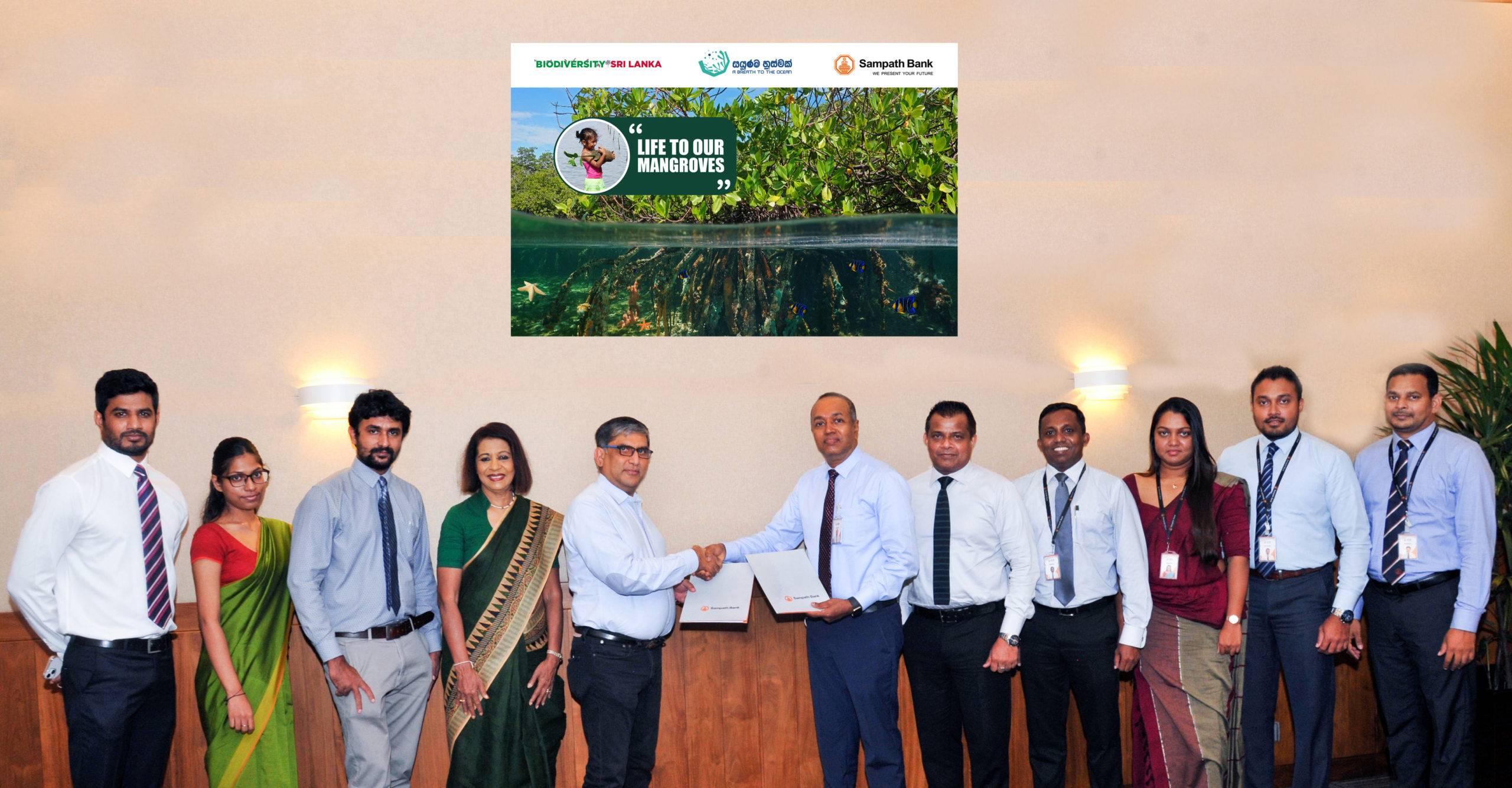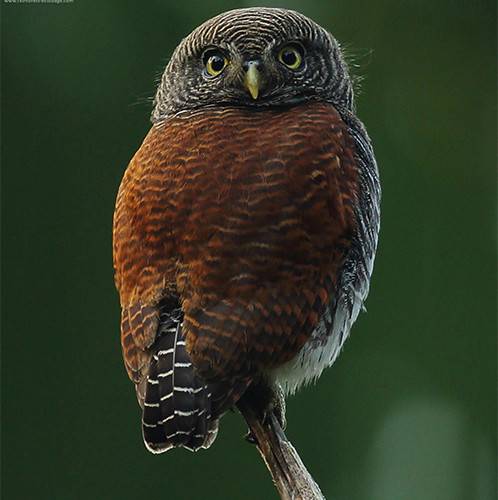
BSL signs a Partnership Agreement with its Patron Member – Sampath Bank LIFE TO OUR MANGROVES
Biodiversity Sri Lanka (BSL) and Sampath Bank PLC exchanged a Memorandum of Understanding to partner in the multi-partner mangrove restoration project as a Nature-based Solution (NbS) using a private-public partnership approach. The project is expected to generate multiple environmental as well as socio-economic benefits. Overall, the intervention will enhance the resilience of the mangrove ecosystem, its capacity for renewal, and the provision of ecosystem services, whilst contributing to the socio-economic development of local communities. The signing took place at the Sampath Bank Head Office by the Bank’s Group Chief Human Resources Officer Mr. Lalith Weragoda and Biodiversity Sri Lanka’s Director Mr. Shahid Sangani who is also the Managing Director of Dynawash Ltd.
On the 12th of December 2021, Biodiversity Sri Lanka and the Department of Wildlife Conservation (DWC) exchanged a Memorandum of Understanding (MoU) to implement this project. Mr. M. G. C. Sooriyabandara, Director-General of the Department of Wildlife Conservation, and Mr. Chandrarathna D Vithanage, Director of Biodiversity Sri Lanka, signed this document at the Department of Wildlife Conservation. The project ‘LIFE To Our Mangroves’ was officially launched on the 7th of February 2022 by Biodiversity Sri Lanka and its members.
Known as ‘the Lungs of the Sea’, mangrove ecosystems provide critical services for the maintenance and well-being of global biodiversity. They are also of equal importance to humans living in the tropical belt, in terms of the ecosystem services that they provide, and the options offered by them as livelihoods to the major proportion of populations that live in the coastal zones of the region. In the context of the single-most debilitating challenge that humankind faces currently, mangroves play a significant role in fighting climate change as unique and productive Carbon sinks, and by acting as a protective barrier for human settlements, against heightened natural disasters resulting from increased global temperatures. Therefore, there is the special and increased focus being laid on the conservation and wise use of mangrove ecosystems around the world.
Mangrove ecosystems cover a land area of 0.23% of the total land area of Sri Lanka. In order to prioritize the protection of these mangrove forests, and more so urgently – a national policy to conserve and sustainably utilize mangrove ecosystems in Sri Lanka, was approved by the Cabinet of Ministers in March 2020.
Anaiwilunda Wetland Sanctuary, which covers an area of 1,397 ha, consists of forest wetlands including mangroves, coastal saltwater ecosystems, and freshwater lakes. It is located along the coastal belt between Chilaw and Puttalam in the Northwestern Province of Sri Lanka. It is one of Sri Lanka’s six RAMSAR wetlands. The sanctuary provides shelter to a host of threatened fish, amphibians, mammals, reptiles, and many migratory birds.
From 44.5 ha of degraded mangrove forest patches within the sanctuary, the DWC has agreed to guide Biodiversity Sri Lanka in initially restoring up to 25 ha, using accepted scientific principles within a period of five years. BSL Members will play an active role in this effort. The first two years will focus on planning, forging community partnerships, land preparation, nursery establishment, and planting activities. Years three-five will be allocated for gap filling and maintenance. Activities will be guided by IUCN’s Global Nature-based Solutions Standard. Baseline monitoring for the entire site is being undertaken by the DWC and monitoring of the BSL site will be in keeping with this overall M&E process.
We look forward to a very fruitful partnership with the Bank!

In commemoration of World Endangered Species Day
The third Friday in May every year is designated as Endangered Species Day. In commemoration, BSL hosted an educational session on endangered species for students from its Patron Member, Stafford International School Colombo. This event reminded us of how vulnerable some animals, plants, and insects are, and inspired us to learn more about why it is so vital to conserve them. This is a day when people talk about solutions and educate their families and friends about how they can help protect certain species. The session for senior students of the school was conducted by Professor Sampath Seneviratne from the Department of Zoology and Environmental Science of the University of Colombo a well-known Molecular Ecology, Evolution and Ornithology Research Scientist.
Several animals have come and gone or become extinct since life originated on Earth, owing to changing physical and biological conditions in the environment. Extinction, as we all know, is a continuous natural occurrence. However, scientific evidence suggests that the current pace of species loss is far faster than the historical rate. This is something we need to consider or is a cause for concern.
Sri Lanka, the pearl of the Indian Ocean has high species diversity, ranging from elephants and leopards to marine turtles and a vast number of birds. There is a big chance of seeing the mighty blue whale in our southern and eastern oceans. Even though Sri Lanka is famous for its wildlife there are a number of wild animal and plant species that are threatened with extinction because of human behavior. Sometimes these threatened flora and fauna go extinct and are lost forever.
Prof Sampath Seneviratne
The focus of the day’s program was on threatened and extinct species. Professor Seneviratne discussed the DNA distribution of certain extinct creatures, such as the clade Dinosauria – the common name given to a group of reptiles, often very large, that first appeared roughly 245 million years ago. Sri Lanka was a peninsula for most of the Indian geological history. Dinosaurs have been discovered on what was India’s northwest coast, present-day Gujarat and Madhya Pradesh. However, we did not discover Mesozoic rock in Sri Lanka because it has either been eroded away to reveal Precambrian rock or has been buried beneath layers of Cenozoic rock. The early human remains in Sri Lanka, for example, can be found in the Balangoda caves. The Mesozoic is represented only by two Jurassic Limestone patches in Puttalam. It is not impossible to find dinosaurs in coastal marine deposits, although none have been discovered so far.
(Picture Credit – The Rainforest Ecolodge – Sinharaja)
Referring to the present context, Professor Seneviratne mentioned that Sri Lanka has a higher number of endemic animal species, as well as one of the highest rates of biological endemism in the world. There are around 21 endemic mammals, 26 endemic birds, 113 endemic reptiles, 112 endemic amphibians, 50 endemic fish, and countless insect species in Sri Lanka, including 24 endemic butterflies such as Mycalesis Rama (Cingalese Bushbrown) and Elymnias Singhala (Ceylon Palm fly). The Sri Lankan junglefowl, Purple-faced langur, and the Sri Lanka Blue Magpie are some of the common endemic fauna, that can be observed in the country. The distribution of these animals across Sri Lanka varies depending on the country’s environmental variability. The Sinharaja World Heritage site is home to 21 of the 26 endemic bird species, making it one of the most endemism-rich ecosystems on the planet.







